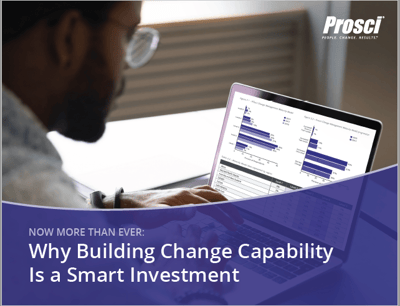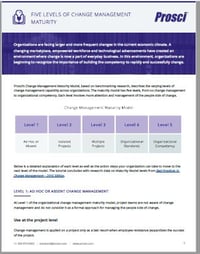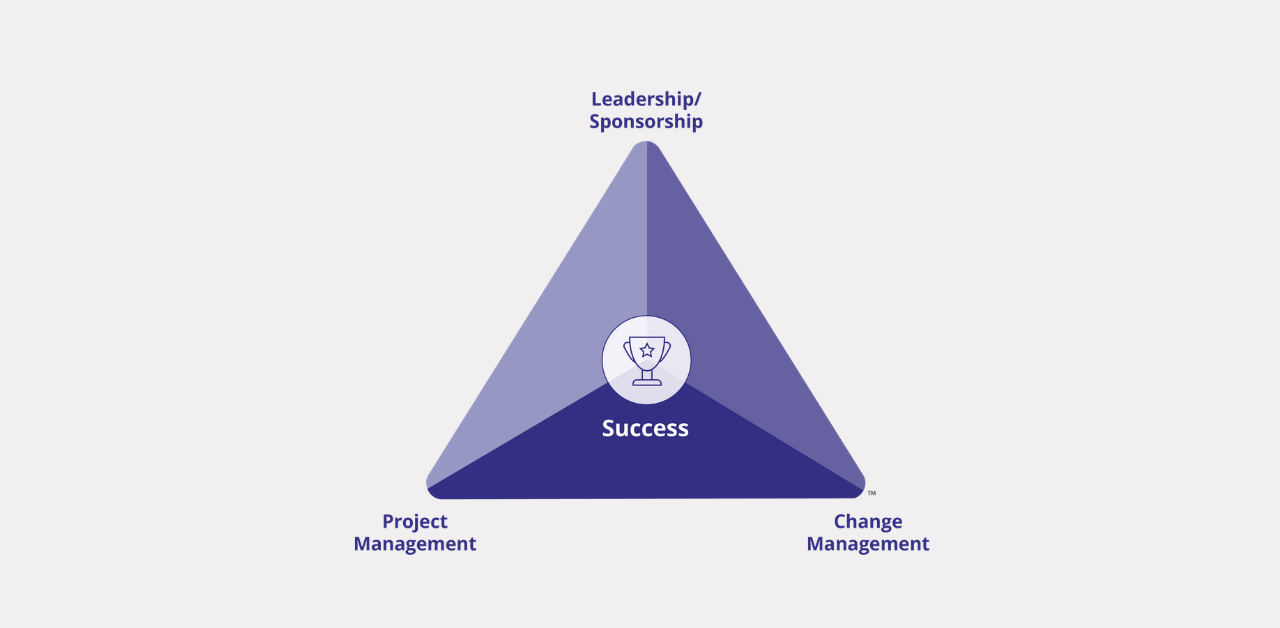Now more than ever, organisations are seeking to build enterprise change management capability in order to increase both their organisational agility, and their overall project success.
One of the ways in which leaders are building this capability, is by creating a structure within the organisation to support change management. Common names for these structures are ‘Change Management Office’, ‘Centre of Excellence’ or ‘Community of Practice’. For the purposes of this blog, we will use ‘change management office’.
The 12th edition of Prosci's Best Practices in Change Management showed that on average, 38% of organisations have a CMO or a functional change management group.
Whatever you decide to call this structure, it is important to realise that there is no defined blueprint for setting up a change management office.
Prosci’s Chief Innovation Officer, Tim Creasey said it best. “We must adapt and adjust to the people and changes at hand and setting up a CMO is no different”.
With this in mind, when first embarking on the journey of establishing a CMO within your organisation, there are four questions that you will want to consider.
- Why should we introduce a CMO?
- What is the role of the CMO and what activities is it responsible and accountable for?
- How will it function within the organisation?
- Where in the organisation will it sit?
It’s important not to forget that building a CMO is a change and will need to be managed like a change. it will be essential to have active and visible sponsorship in place upfront. Let’s delve deeper.
Download: Why Building Change Capability is a Smart Investment
Why should we introduce a change management office?
As touched upon at the beginning of this blog, establishing a CMO is one of the many ways in which leaders are trying achieving enterprise change capability. Building ECM capability is the core competency we strive for most. But why is this?
- It’s essential to organisational agility
- Reduces change saturation Supports strategy
- Provides a competitive advantage
- Multiplies the benefits of change management
As Prosci’s Tim Creasey said- “the winners of the future will be those who ‘out-change’ the competition”.
Also, a dedicated change management function in an organisation will only amplify the benefits of practising effective change management. These benefits include:
- A six-fold increase in the likelihood in achieving your results and outcomes
- An increase in the likelihood of projects being on time and on budget
- Mitigating risks
What is the role of a CMO?
It is important that the roles and responsibilities of the CMO are formally chartered. Whatever it is that is agreed that the roles and activities are, they need to be formally documented. To reiterate, there’s no right or wrong blueprint to introducing a CMO, as it must be tailored in a way that best suits your organisation.
However, some examples of the roles and responsibilities of a CMO include;
- Owning and maintaining the change management methodology
- Provision of coaching to sponsors
- Consultative support to project teams
There may also be a difference of approach depending on whether your organisation is flush with change management practitioners.
If yes, some of the roles of your CMO may include;
- Deploying the methodology
- Provision of change management tools
- Provision of project success summaries
If you don’t have access to change management practitioners, then roles may include;
- The provision of consultative support
- Acting as a resource for your project management team
- Provision of change management training (external or internal) or resources
Download: Five Levels of Change Maturity
How will it function in your organisation?
When talking about how your CMO will function within your organisation, we refer to it being centralised or decentralised, or somewhere in-between. Prosci refer to this as the ‘Centralised and de-centralised spectrum’.
Prosci define centralised as one, singular CMO, and de-centralised being more of a community of practice.
Again, there isn’t a right or wrong approach to this. You must ask yourself the question, what would be right for my organisation?
There are pros and cons to both ends of the spectrum. The pros for a centralised change management office include; centralised resources, access to budget and standardisation.
The pros for a de-centralised CMO include; practitioners being closer to where the impact of the change is happening, being more localised to those areas and being able to connect more closely to areas of lower change management maturity. Therefore, if you’re part of a large organisation across many territories, this may be the approach for you.
Where in the organisation will it sit?
Without trying to sound like a broken record, I will re-iterate that there is no one-true answer. The CMO can be found in one area of the organisation, or many areas. However, the findings in Prosci’s Best Practices research will give you an idea of what other organisations are doing.
According to the data, 62% of respondents said that their CMO was in one location, with 21% being in the PMO (project management office) and 18% responding that their CMO was within HR.
Prosci research indicates that the number of locations in which the CMO sits, correlates with the level of change maturity level of maturity in an organisation. The higher level of maturity, the more locations the CMO sits. So depending on where your organisation is, this will determine your approach.
When asked where DOES the CMO sit, the most popular answer was within the PMO, with 32% of responses. When asked where SHOULD the CMO sit, 22% responded within the PMO. However, that was second to the most popular answer, with 24% of the vote, within Strategy and Transformation.
To conclude this blog, it is imperative that before embarking on this journey you treat it just like any other change project upfront, by appointing the right sponsor.
These four questions will help in shaping the establishment of a change management office within your organisation. The answers to these questions will help determine how a CMO would look in your organisation, and how best it would function.
Start your organisation's journey towards enterprise change capability by joining our upcoming Enterprise Change Management Boot Camp!
If you've been tasked with developing your organisation's change management capability, consider joining one of our upcoming Prosci Enterprise Change Management Boot Camps in Singapore! Register here.
This workshop is also available privately for organisations in either a virtual or face-to-face format. Get in touch for more information!




